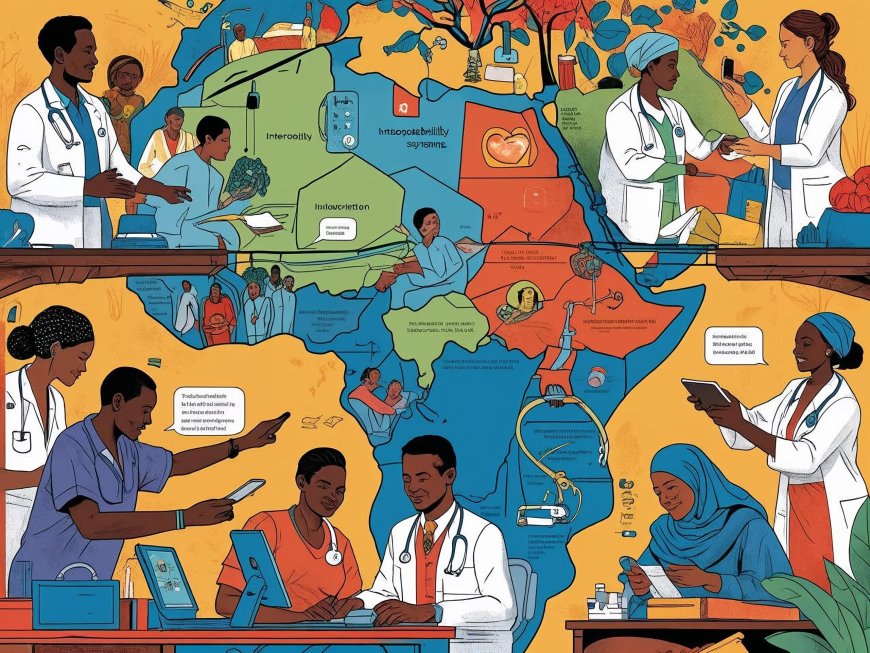Interoperability in African Health Systems: From Concept to Reality
This white paper explores the journey from theory to implementation of interoperability in African health systems. It highlights key frameworks, country case studies, and practical challenges while offering actionable strategies for achieving seamless health data exchange across the continent.

Abstract
Interoperability—the ability of health systems to communicate, exchange, and use data effectively—is foundational to delivering equitable, data-driven healthcare. While African nations increasingly recognize its importance, implementation remains uneven. This white paper traces the evolution of interoperability efforts in Africa, highlighting successes, ongoing challenges, and actionable recommendations for building a truly connected health ecosystem.
Introduction
With the rise of digital health interventions in Africa—including electronic medical records (EMRs), mHealth apps, and health data dashboards—interoperability has emerged as a critical priority. Yet, fragmented systems, donor-driven pilots, and lack of policy coherence have limited progress (World Health Organization [WHO], 2021). Without interoperability, siloed health data hampers continuity of care, disease surveillance, and strategic planning.
“Interoperability is not a technical issue; it’s a political, organizational, and human one.”
— WHO Africa Interoperability Workshop, 2022
What Is Interoperability?
Interoperability refers to the ability of disparate information systems, devices, or applications to connect and exchange data in a coordinated and useful manner. It occurs on several levels:
-
Foundational: Basic data exchange (e.g., lab results via PDF)
-
Structural: Common formats like HL7, CDA, or JSON
-
Semantic: Standardized vocabularies (e.g., ICD-10, SNOMED CT)
-
Organizational: Governance, legal frameworks, and consent protocols
The African Interoperability Landscape
1. Progress & Pilots
-
Rwanda: Integrated the Babyl telehealth platform with national EMRs and citizen ID systems (Babyl, 2023).
-
Kenya: MOH’s Kenya Health Information System (KHIS) integrates over 70 systems via OpenHIE standards (MOH Kenya, 2021).
-
Uganda: Launched the Uganda Health Interoperability Layer (HIL) for system linkages using FHIR and OpenHIM.
-
Sierra Leone & Ethiopia: Developed national interoperability roadmaps in collaboration with WHO and Digital Square.
2. Technical Tools in Use
-
OpenHIE: An architecture supporting scalable data exchange
-
OpenMRS: Modular, open-source EMR system
-
DHIS2: Widespread for health data reporting
-
FHIR (Fast Healthcare Interoperability Resources): Becoming the de facto data standard
-
OpenHIM: Middleware for routing health data between systems
Challenges to Achieving Full Interoperability
1. Fragmented Digital Ecosystems
Many countries operate multiple, donor-funded digital systems with no standard protocols for data exchange or shared governance (Path, 2020).
2. Weak Policy & Legal Frameworks
Only a few African countries have fully ratified digital health or data-sharing laws. Data privacy laws (like Nigeria's NDPR or Kenya's Data Protection Act) are often not tailored to health data contexts.
3. Infrastructure Barriers
Low internet penetration, power outages, and server instability impede real-time data flows between facilities or platforms.
4. Human Resource Gaps
There’s a shortage of health informaticians and IT staff trained in FHIR, HL7, and integration middleware (GIZ, 2022).
5. Sustainability & Donor Dependency
Most integrations are funded short-term by external donors, with limited national ownership or continuity strategies.
Strategic Recommendations
1. Develop National Interoperability Frameworks
Countries should align to the WHO Digital Health Framework and develop national guidelines that define data standards, system certification, and integration priorities.
Framework Reference: https://apps.who.int/iris/handle/10665/336134
2. Mandate Use of Open Standards
Legislate the adoption of FHIR, HL7, and ICD-10 for any public health IT procurement. Incentivize compliance among private providers and developers.
3. Invest in Health Information Exchanges (HIEs)
Establish national or regional HIEs using OpenHIE architecture. Rwanda’s Health Information Exchange prototype is a promising model.
4. Strengthen Governance & Stakeholder Alignment
Create digital health steering committees that bring together ministries, tech vendors, donors, and civil society to guide integration.
5. Upskill the Workforce
Develop certificate and degree programs in digital health and interoperability (e.g., through AMREF or African CDC academies).
Country Spotlight: Kenya
Kenya’s KHIS (Kenya Health Information System) is a model for structured interoperability:
-
Integrates >70 subsystems
-
Uses DHIS2 as the reporting backbone
-
Employs OpenHIE-based architecture
-
National Health Data Warehouse (NHDW) acts as a central repository
-
Enforces unique identifiers and FHIR compliance in procurement
Read more: https://www.health.go.ke/khis/
Conclusion
Interoperability is essential for the transformation of African health systems. Moving from theory to reality requires investment not only in technology—but in governance, standards, and people. African countries must prioritize interoperability as a national asset, enabling data-driven decisions, stronger health outcomes, and resilient digital infrastructure for the future.
References (APA 7th Edition)
Babyl Rwanda. (2023). Partnering with the Government of Rwanda. https://www.babyl.rw
GIZ. (2022). Digital health capacity building in Africa: Gaps and opportunities. https://health.bmz.de
MOH Kenya. (2021). Kenya Health Information System (KHIS). https://www.health.go.ke/khis/
Path. (2020). Digital health in Africa: Interoperability assessment toolkit.
https://path.azureedge.net/media/documents/DT_interoperability_assessment_toolkit.pdf
World Health Organization. (2021). Global strategy on digital health 2020–2025. https://apps.who.int/iris/handle/10665/336134
OpenHIE Community. (2024). OpenHIE architecture overview. https://wiki.ohie.org/display/SUB/OpenHIE+Community
What's Your Reaction?
 Like
0
Like
0
 Dislike
0
Dislike
0
 Love
0
Love
0
 Funny
0
Funny
0
 Angry
0
Angry
0
 Sad
0
Sad
0
 Wow
0
Wow
0



















































